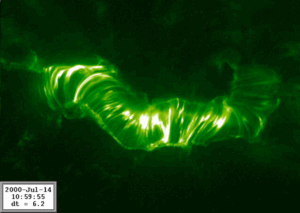 “Bastille Day” solar eruption as seen by the TRACE satellite
“Bastille Day” solar eruption as seen by the TRACE satellite
About our Project:
Despite intense research efforts over the past decades, the physical mechanisms that initiate large-scale solar eruptions such as flares and coronal mass ejections (CMEs) are still not well understood, which strongly hampers our ability to forecast their occurrence and, ultimately, their impact on Earth and other planets. Uncoveringthese mechanisms, therefore, remains one of the most significant and challenging tasks in Solar and Heliospheric Physics.
To achieve progress, we need to (1) better understand the roles of key processes such as ideal magnetohydrodynamic (MHD) instabilities and magnetic reconnection and (2) unravel the contribution of the preceding slow rise phase, which entails a potential paradigm shift in our conception of the onset of solar eruptions. Upcoming missions will, for the first time, enable us to directly observe reconnection in the corona and study it in the whole chromosphere-to-corona region(via rapid Doppler imaging in EUV with the MUlti-slit Solar Explorer [MUSE] and wide temperature range [full VUV] plasma diagnostics with the Extreme UltraViolet high-throughput Spectroscopic Telescope [EUVST] onboard Solar-C). Paired with the continuous advances in the numerical modeling of solar eruptions, this creates a timely opportunity for a concentrated effort to tackle these scientific tasks.
We have assembled an international team of expert observers and modelers to systematically address the most important open questions related to the onset of solar eruptions, and to formulate strategies for making best use of the observational capabilities of upcoming missions such as MUSE and Solar-C.
